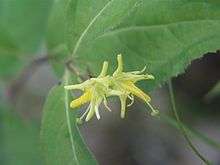Diervilla lonicera
Diervilla lonicera, commonly referred to as northern bush honeysuckle, low bush honeysuckle, dwarf bush honeysuckle, or yellow-flowered upright honeysuckle, is a deciduous shrub native to the northeastern United States and Canada. Its specific epithet, lonicera (the Latin term for ‘honeysuckle’) refers to its similarity in appearance to the true honeysuckles, genus Lonicera.
| Diervilla lonicera | |
|---|---|
 | |
| Scientific classification | |
| Kingdom: | Plantae |
| Clade: | Tracheophytes |
| Clade: | Angiosperms |
| Clade: | Eudicots |
| Clade: | Asterids |
| Order: | Dipsacales |
| Family: | Caprifoliaceae |
| Genus: | Diervilla |
| Species: | D. lonicera |
| Binomial name | |
| Diervilla lonicera | |
Description
Northern bush honeysuckle is a deciduous shrub, reaching a maximum height between 0.6 and 1.2 metres.[1] This particular species is known for the following characteristics: branches lying close to the ground, fibrous roots, pale yellow flowers, and dry, woody fruit. Northern bush honeysuckle's simple leaves are placed in an opposite arrangement. As the seasons change, so do the leaves' colours: initially green, the leaf gradually deepens to a dark red.[2] The flowers are in full bloom between early July and early August; the woody seeds are fully matured by September in preparation for dispersal.
Diervilla lonicera has protogynous flowers (initially female-dominant plant), is well-adapted for pollination, and its stigmas remain receptive after anthesis (fully functioning flower).[3]
Habitat
Exposed rocky sites, combined with the plant's tolerance for cool climates, dry, or infertile soils are varying characteristics to describe a typical habitat for Diervilla lonicera. It is commonly found in forests dominated by balsam fir (Abies balsamea) and jack pine (Pinus banksiana).[1] Unlike some plant species that are restricted to specific light conditions, the northern bush honeysuckle is insensitive to changes in light, allowing for broader ranges of habitat. In addition, it is well-adapted to fire-prone habitats, because it can regenerate quickly from underground stems if destroyed by fire. For example, D.J. Schoen found that Diervilla lonicera was the most abundant shrub over a 50-year span on dry ground areas that were destroyed by fire.[3]
Range
Northern bush honeysuckle is found widely spread across most of North America. It grows all along the east coast of the continent, from Northern Quebec and Labrador to Georgia and Alabama and reaches as far west as Saskatchewan. Bush honeysuckle was also introduced to parts of Europe sometime in the eighteenth century, but the exact year is unknown.[4]
Importance to humans
Plants from the honeysuckle family are commonly used for herbal cough medicine. The most common use is as an herbal tea for sore throats, but there are also recipes for a cough syrup derived from the leaves and flowers of the vines mixed with honey. Some of these remedies have been able to rival the results of store-bought medicines. It is unknown whether or not Northern bush honeysuckle is any more effective than any other species of bush honeysuckle.
These types of recipes can be found on many online cooking websites, but it is very important to be aware of the dangers involved. Some species of honeysuckle can be poisonous, so it is best to use extreme caution and should not be attempted by anyone who is not an expert in this field.
Importance to ecosystems
The northern bush honeysuckle is a popular food source for a number of animal species. For example, moose consume the shrub and its fruit as a winter food source, whereas white tailed deer consume the plant in both the summer and winter (although preferred in the late summer).[1] The Diervilla lonicera shrub may also be important for sustaining populations of pollinators. This shrub's long and flexible style and readily accessible flowers (produced in large quantities) are known to draw significant numbers of bumble bees.[5]. Diervilla lonicera is also the only recorded host plant for the recently described hawkmoth Hemaris aethra.[6]
Bird species also make use of the shrub. Nests are often constructed from its branches for protection from the elements, and the fruits serve as a readily available food source. Diervilla lonicera may even be responsible for triggering population increases and range expansion among various avian species.[7]
Conservation
Northern bush honeysuckle is generally abundant and widespread in North America; it is only considered to be threatened in Tennessee and rare in Indiana. Neither Canada, nor any of the other American states, has bush honeysuckle registered on a threatened or endangered list.[4]
References
- Sullivan, J. (1993). "Diervilla lonicera". Fire Effects Information System (FEIS). US Department of Agriculture (USDA), Forest Service (USFS), Rocky Mountain Research Station, Fire Sciences Laboratory. Retrieved 24 October 2011 – via https://www.feis-crs.org/feis/.
- Jacobs, B.; Lens, F.; Smets, E. (2009). "Evolution of fruit and seed characters in the Diervilla and Lonicera clades (Caprifoliaceae, Dipsacales)". Annals of Botany. 104 (2): 253–276. doi:10.1093/aob/mcp131. PMC 2710890. PMID 19502353.
- Schoen, D.J. (1977). "Floral Biology of Diervilla lonicera (Caprifoliaceae)". Bulletin of the Torrey Botanical Society. 104 (3): 234–240. JSTOR 2484303.
- "Diervilla lonicera". Natural Resources Conservation Service PLANTS Database. USDA. Retrieved 23 October 2011.
- Thomson, J.; Plowright, R.C. (1980). "Pollen Carryover, Nectar Rewards, and Pollinator Behavior with Special Reference to Diervilla lonicera". Oecologia. 46 (1): 68–74. doi:10.1007/BF00346968. PMID 28310628.
- Schmidt, B. Christian. "Cryptic species among bumblebee mimics: an unrecognized Hemaris hawkmoth (Lepidoptera: Sphingidae) in eastern North America". Zootaxa. pp. 32–48. Archived from the original on 7 January 2020. Retrieved 18 January 2020.
- McCusker, C.E.; Ward, M.P.; Brawn, J.D. (2009). "Seasonal responses of avian communities to invasive bush honeysuckles (Lonicera spp.)". Biological Invasions. 12 (8): 2459–2470. doi:10.1007/s10530-009-9655-5.